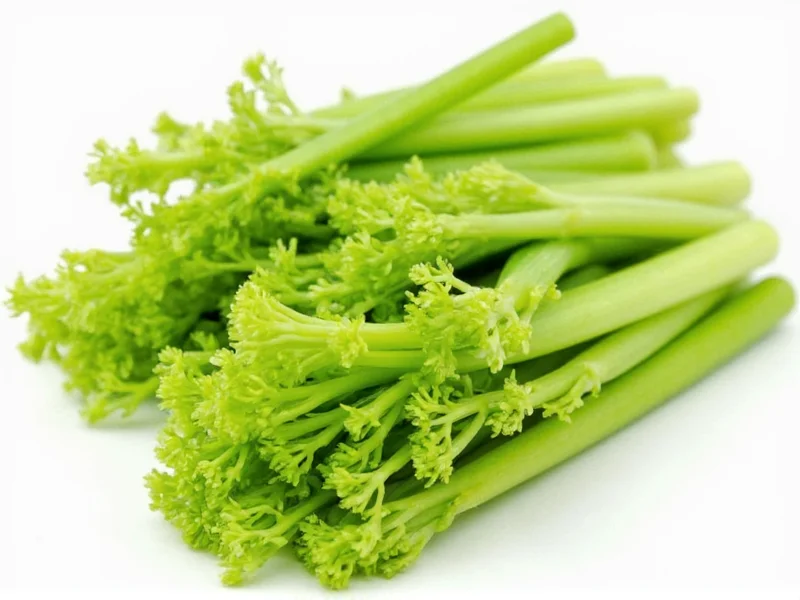Celery seeds (Apium graveolens) come from the same plant that produces the familiar celery stalks, but they offer a more intense, earthy flavor profile. Harvested from the flowering celery plant, these minuscule seeds have been valued across cultures for centuries not just for their distinctive taste but also for their potential health-supporting properties. Understanding their proper applications can transform your cooking and potentially support wellness routines.
Culinary Applications of Celery Seeds
Chefs and home cooks prize celery seeds for their versatility in the kitchen. Unlike celery stalks which lose flavor when dried, celery seeds actually intensify in taste, making them ideal for dry spice blends and long-cooking dishes.
Essential in Spice Blends and Seasoning Mixes
Celery seeds form the backbone of several classic seasoning combinations:
- Celery salt - A 3:1 ratio of salt to celery seeds creates this pantry staple
- Old Bay seasoning - Celery seeds provide the distinctive base note
- Chicago-style hot dog seasoning - Essential for authentic flavor
- Seafood boils - Complements shellfish and fish dishes perfectly
Perfect for Long-Cooking Dishes
The robust flavor of celery seeds withstands extended cooking times better than fresh celery. They excel in:
- Bean and lentil soups (add 1/4 teaspoon per pot)
- Vegetable and bone broths (enhances umami)
- Stews and chili (use sparingly to avoid bitterness)
- Brines for pickling vegetables (1 teaspoon per quart)
| Dish Type | Recommended Amount | When to Add |
|---|---|---|
| Soups & Stews | 1/4-1/2 tsp per serving | Early in cooking |
| Salad Dressings | 1/8-1/4 tsp per cup | During mixing |
| Pickling Brines | 1 tsp per quart | With other spices |
| Bread & Rolls | 1/2-1 tsp per loaf | With dry ingredients |
Traditional and Potential Health Applications
While modern research continues to investigate celery seeds' properties, traditional medicine systems have utilized them for various purposes. It's important to note that celery seeds should complement, not replace, medical treatment.
Anti-Inflammatory Properties
Studies suggest that 3-n-butylphthalide (3nB), a compound found in celery seeds, may help reduce inflammation. A 2020 review in Phytotherapy Research noted potential benefits for joint health when consumed as part of a balanced diet. However, therapeutic effects require concentrations higher than typical culinary use provides.
Digestive Support
Traditional European herbalism often employed celery seeds to support digestion. The seeds contain compounds that may stimulate digestive enzymes. Many people find that a pinch of celery seeds in broth or tea after meals helps with comfort.
Nutritional Profile Comparison
While used in small quantities, celery seeds offer concentrated nutrition compared to their stalk counterparts:
| Nutrient | Celery Seeds (1 tsp) | Celery Stalk (1 medium) |
|---|---|---|
| Calories | 8 | 6 |
| Fiber | 0.6g | 0.6g |
| Calcium | 25mg | 16mg |
| Potassium | 75mg | 104mg |
| Magnesium | 10mg | 5mg |
Practical Usage Tips for Home Cooks
Maximize the flavor potential of celery seeds with these professional techniques:
Dry Roasting for Enhanced Flavor
Place seeds in a dry skillet over medium heat for 1-2 minutes until fragrant. This simple step releases essential oils and creates a more complex flavor profile. Let cool before using in recipes.
Creating Custom Blends
Combine celery seeds with complementary spices for signature blends:
- Vegetable Boost Mix: 2 parts celery seeds, 1 part dried thyme, 1 part garlic powder
- Seafood Enhancement: 3 parts celery seeds, 2 parts dill seed, 1 part lemon zest
- Heartier Winter Blend: 2 parts celery seeds, 1 part smoked paprika, 1 part mustard seed
Substitutes When Celery Seeds Are Unavailable
If your recipe calls for celery seeds but you don't have any, consider these alternatives:
- Celery salt - Use 1/2 teaspoon celery salt for every 1/4 teaspoon celery seeds (adjust overall salt)
- Fennel seeds - Provides similar earthiness but with licorice notes (use 3/4 amount)
- Asafoetida (hing) - Powerful substitute in Indian cooking (tiny pinch replaces 1/4 tsp seeds)
- Ground celery - Dehydrated celery stalks ground to powder (use 3 times the amount)
Safety Considerations and Proper Storage
While generally safe for culinary use, celery seeds require some considerations:
Potential Sensitivities
Some individuals with celery allergies may react to the seeds, though reactions are typically less severe than to celery stalks. Those with existing kidney conditions should consult healthcare providers before consuming celery seeds medicinally, as they contain compounds that affect kidney function.
Optimal Storage Practices
To preserve flavor and potency:
- Store in airtight container away from light and heat
- Whole seeds maintain quality for 2-3 years (ground loses potency in 6 months)
- Refrigeration extends shelf life but may cause clumping
- Freezing is acceptable for long-term storage (up to 5 years)
Common Questions About Celery Seeds
Celery seeds remain a valuable pantry staple that bridges culinary and potential wellness applications. Their concentrated flavor makes them indispensable in certain recipes, while their traditional uses continue to inspire modern research. When used appropriately in cooking, they add depth and complexity that few other spices can match. Remember that while celery seeds offer potential health benefits, they work best as part of a balanced diet rather than as standalone remedies. Proper storage ensures you'll always have this versatile spice ready for your next culinary creation.











 浙公网安备
33010002000092号
浙公网安备
33010002000092号 浙B2-20120091-4
浙B2-20120091-4